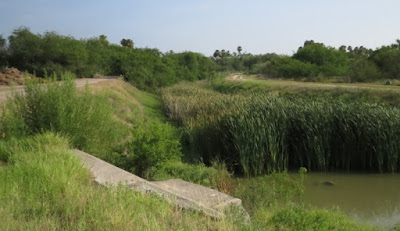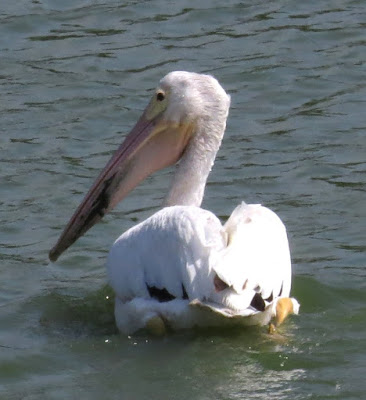Clayton,
a journalist with Texas Highways,
wanted to write an article about the Valley, found our hotel, and booked a room
and a guide (me)! J
Neither she nor her photographer Kenny were birders, but their purpose
was to do a “go with the flow” type of trip to the Valley (no GPS, and no
technology – just reading the maps the old fashioned way J), and seeing
Santa Ana was high on their list. So we
took off very early this morning to beat the heat!
We
even beat the automatic gate going in J, but as I warned
them, we’d probably hear a lot more than we’d see this time of year! So I tried to point out what I was hearing: White-winged and White-tipped Doves,
Clay-colored Thrushes, and Olive Sparrows were amongst the early-morning
songsters, and as we got out of the car a Chachalaca posed on a tree (which was
also big on Clayton’s “wish list”), but didn’t stay around for a scope view…
It
was just after sunrise when we got there, so Kenny wanted to try and get some
early morning shots in an open area, so we headed to Pintail Lakes first. It was a beautiful morning and was actually
quite pleasant to start; going over the levee we had a pair of Roseate
Spoonbills fly past, and once out in the open and by the lakes a pair of
Mottled Ducks greeted us first off (but again, didn’t stick around for scope
views), and an adult and immature Yellow-crowned Night Heron posed on some dead
branches. A pretty Black-bellied
Whistling Duck sat out in the lake, so we scoped him while Kenny took pictures
of us enjoying the duck! J
On the Pintail Lakes Trail
Clayton and Kenny
A
Common Ground Dove sang and then darted past, but then I heard a Ringed
Kingfisher call, so we hightailed it down to the last lake (also to get the sun
to our backs) and were greeted with lots
more night herons! Each lake is numbered
(and I keep forgetting which is which L), but the lake we
ended up at had lots of Pied-billed Grebes on the nest, trumpeting Least
Grebes, both Neotropic Cormorants and an Anhinga drying their wings, and
Black-necked Stilts flying overhead!
Both Tropical Kingbird and Great Kiskadee gave us scope looks, and
before long I heard a Blue Grosbeak singing – and there he was, right on
top! What a looker!
Yellow-crowned Night Heron on the trail...
...and on the wood!
The
kingfisher was in a tree along the
trail, but obscured by branches, and as we tried to get closer he took off, but
thankfully landed on a branch across the pond which was actually in great
light! So everyone got scope looks at
him before he took off and showed off his lovely chestnut underparts! Both Great Egrets and a Great Blue Heron flew
in; Clayton relayed a story where one seemed to follow them all the way down
the Guadalupe River on a boat trip! I
heard an ani, but never could spot him, telling my charges that he looks kinda
like a grackle with a big schnozz!
Clayton enjoying scope views of the Ringed Kingfisher
We
headed back after that, enjoying a pair of Blue-winged Teal that had joined the
Mottled Ducks and a female Marl Pennant (until told otherwise) watching us from a stem! Some Lesser Goldfinches
fed in some sunflowers along the main trail, and taking the cutoff trail back
to the tour road bagged us a pair of Altamira Orioles! Up on the road a Beardless Tyrannulet called loud
and clear, but as per usual wouldn’t let us get a look… L We were on our way to the Willow Lakes connector
trail and enjoying a Yellow-billed Cuckoo when the Rare Bird Alert went off on
my phone: a Mexican Violetear (which had
initially shown up the day before at Quinta Mazatlan) had reappeared! When I told them how rare this bird was (a
life bird for me, definitely) and suggested they may want to write about chasing
a rarity as part of the “birding culture” (plus the fact that the mansion
itself has such a great history), they were very game! So we double-timed it back to the car and
headed to Quinta Mazatlan!
Female Marl Pennant
Kenny getting some photo ops
We
found a spot in the almost-full parking lot, and right away the Chachalacas
were doing their thing right there in the lot, spreading the morning news! A Clay-colored Thrush zipped in while a Curve-billed
Thrasher fed on the ground, but we quickly headed in, checked in, then found
the clearing behind the amphitheater where the bird had been hanging out. My friend Pat and I had zipped over the
previous day and dipped (Keith gave his blessing to take a long lunch hour J), but we saw old
friends, and practically the same crowd was back today! The bird wasn’t visible when we walked up,
but we gave it about 15 minutes before exploring the rest of the place, and in
good journalist fashion, Clayton “interviewed” Mary G., Lizee C., and I think
even Simon K. a little! I had explained
that this bird was a recent “split”:
what used to be known as Green Violetear – ranging from Mexico down into
South America – was now the Mexican Violetear (for the birds in Mexico down to
Honduras) and Lesser Violetear (everything south of there). I wasn’t sure what the split was based on, so
Mary gave us a rundown on the subtle differences in plumage and vocalizations. In the meantime we enjoyed a little female
Black-chinned Hummer that came in, and a family of Chachalacas that came right
out on the road!
After
a while the group broke up while we waited out the 15 minutes, hearing a Hooded
Oriole sing and a cowbird rattle (Clayton didn’t think very highly of their
parasitic habits)! After said 15 minutes
I took my charges on a stroll around the main trail, where we had more closeup
looks at Chachalacas, a family of Ladder-backed Woodpeckers, and a baby
Curve-billed Thrasher being chased by an adult!
Clayton enjoyed the animal statutes (in case you didn’t see the real
thing J). We were just coming out of the Ebony Grove where
I had been showing them the Green Parakeet nesting trees area when another
alert came over my phone – the bird was back!
So we zipped back over there (along with everyone else who had gotten
the alert) and again, the bird was gone by the time we got there… L But this time he didn’t stay away long: I
think both Mary and Lizee announced at once that they had the bird, and this
time he posed just beautifully! I
eventually got the scope on him, and Clayton was just delighted with this
sparkling little guy! Even Kenny was
able to get a digiscoped picture (which he immediately posted on Facebook J)!
Clayton enjoying the statuary
A young Ladder-backed Woodpecker entertains us with its acrobatics!
Back at the watch site, Lizee, Mary, and Simon enjoy the vagrant Mexican Violetear (below)!
After
that Clayton and Kenny explored the old mansion while the rest of us continued
to enjoy the violetear, then eventually called it a day. We had a modest 60 species for the morning,
but you couldn’t beat the quality! Bird
List:
Black-bellied Whistling-Duck
Mottled Duck Blue-winged Teal
Plain Chachalaca
Least Grebe
Pied-billed Grebe
Neotropic Cormorant
Anhinga
Great Blue Heron
Great Egret
Yellow-crowned Night-Heron
Roseate Spoonbill
Turkey Vulture
Common Gallinule
American Coot
Black-necked Stilt
Killdeer
Eurasian Collared-Dove
White-winged Dove
Mourning Dove
Common Ground-Dove
White-tipped Dove
Yellow-billed Cuckoo
Groove-billed Ani
Chimney Swift
Mexican Violetear
Black-chinned Hummingbird
Buff-bellied Hummingbird
Ringed Kingfisher
Golden-fronted Woodpecker
Ladder-backed Woodpecker
Northern Beardless-Tyrannulet
Brown-crested Flycatcher
Great Kiskadee
Tropical Kingbird
Couch's Kingbird
White-eyed Vireo
Green Jay
Purple Martin
Bank Swallow
Black-crested Titmouse
Verdin
Carolina Wren
Clay-colored Thrush
Curve-billed Thrasher
Long-billed Thrasher
Northern Mockingbird
European Starling
Common Yellowthroat
Olive Sparrow
Northern Cardinal
Blue Grosbeak
Dickcissel
Red-winged Blackbird
Great-tailed Grackle
Brown-headed Cowbird
Hooded Oriole
Altamira Oriole
Lesser Goldfinch
House Sparrow
60 SPECIES


























